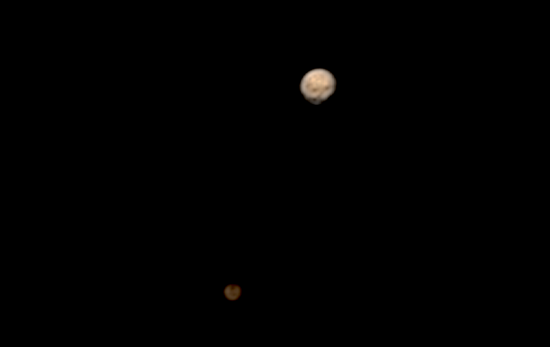Jun 26, 2015
New Horizons is days away from Pluto.
At 7:49:57 AM Eastern Daylight Time on July 14, 2015 the New Horizons space probe will fly by the dwarf planet Pluto at a distance of 9656 kilometers. It is expected that RALPH (named after Alice’s husband in the television show The Honeymooners) will be able to resolve color features on Pluto that are 50 meters across (about a city block).
New Horizons was launched on January 19, 2006 so Electric Universe proponents have been awaiting its arrival for some time. Expectations are that, like the Dawn mission to Vesta and Ceres, it will confirm ideas that take issue with conventional ideas about the Solar System that are discussed in previous Pictures of the Day: the Nebular Hypothesis, for example.
Pluto’s mean distance from the Sun varies due to a highly eccentric orbit. Aphelion takes it out as far as 7.3 billion kilometers, while perihelion brings it no closer to the Sun than 4.4 billion kilometers, which means it takes about 248 years for it to complete one revolution. The last time Pluto was in the same place in its orbit as it is now was ten years before the American war for independence in 1776.
Pluto is small, only about a third the mass of the Moon. It is thought to be similar in composition to most remote bodies, like Triton, composed primarily of rock and ice. No one is sure, at this point, what its chemical makeup really is.
It has long been known that Pluto and Charon are more like a binary system, since they orbit around a common barycenter. The two objects are also beginning to reveal their individual characteristics, as the image at the top of the page indicates. Pluto is a dark beige color, while Charon exhibits a rusty hue. Whether this reveals variations in their compositions or indicates surface deposits remains to be seen. It has been shown in past Picture of the Day articles that many moons in the Solar System are covered in a rust-red dust.
Pluto has several moons: Charon is the largest, followed by Styx, Kerberos, Hydra, and Nix. Although, as previously mentioned, Pluto and Charon orbit a common center, so the other four moons are circling them. There might be other moons too dim to see, so New Horizons could add to the count of innumerable moons in the Solar System: as of this writing, 181 moons orbit the planets, 97 moons orbit bodies in the asteroid belt, 79 moons orbit Trans-Neptunian Objects, 55 named Near Earth Objects have moons, etc.
After its close encounters with Pluto and Charon, New Horizons is scheduled to visit a small Kuiper Belt Object known as 2014 MT69 in January 2019.
Stephen Smith













